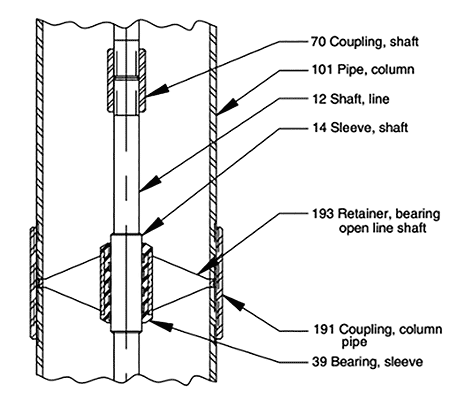
Shaft vibration is most commonly measured on large pumps with sleeve bearings and done using proximity probes mounted near the bearing. Shaft vibration is not commonly measured on pumps with rolling element bearings.
When shaft vibration is measured, there are typically two proximity probes radially mounted 90 degrees apart at the inboard and outboard sleeve bearings (Image 1, items 16 and 18) so the centerline and orbit of the shaft can be plotted. This allows the vibration monitoring system to determine if shaft displacement exceeds the sleeve bearing clearance. The proximity probes and monitoring can be part of a safety system that senses when displacement exceeds a set value and can alarm or shut the equipment down to prevent a more significant failure.

There are some pumps with sleeve bearings with which shaft vibration is not commonly measured.
Vertically suspended pumps utilize sleeve bearings to support a lineshaft that connects to a pumping element that is submerged or partially submerged. In these pumps, sleeve bearings can be spaced every 5 to 10 feet along the lineshaft (Image 2, item 39), and it is not practical or common to measure shaft vibration on these pumps at the sleeve bearings. Proximity probes can be permanently or temporarily mounted on vertical line shaft pumps at an above-ground location above the seal location and below the coupling. This single point of shaft vibration data, along with other vibration data, can be used by analysts to determine if a vibration problem exists and the potential cause.

Sealless canned motor pumps utilize sleeve bearings to support the motor rotor and pump shaft (Image 3, items 237 and 235). These pumps are designed to be hermetically sealed with no exposed shaft, and it is not a practical design objective to penetrate the hermetically sealed unit to install proximity probes. These pump types often come with a bearing wear monitoring system proprietary to the manufacturer. These systems work by sensing the position of the shaft and if it goes beyond the sleeve bearing clearance, but are not typically used to measure shaft vibration by an analyst.

For more information on pump conditioned monitoring, refer to ANSI/HI 9.6.5 Rotodynamic Pump Guideline for Condition Monitoring and ANSI/HI 9.6.9 Rotary Pumps Guideline for Conditioned Monitoring at pumps.org.

